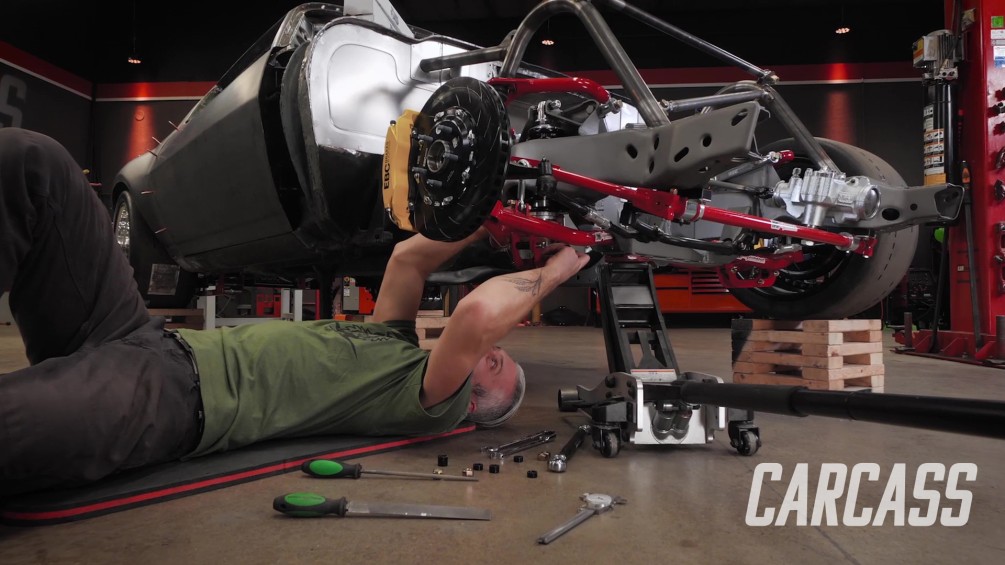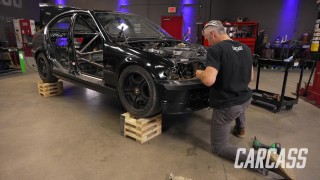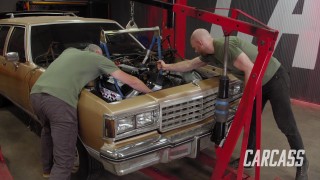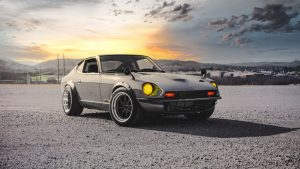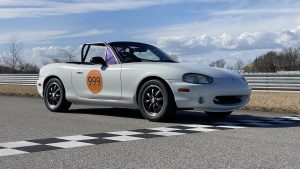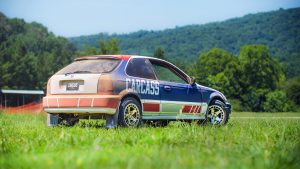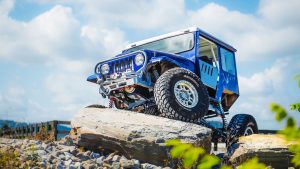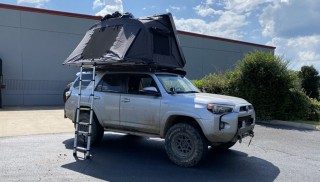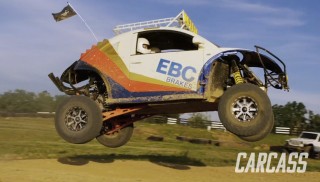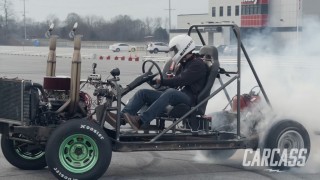Carcass Featured Projects
Carcass Builds
Want more content like this?
Join the PowerNation Email NewsletterParts Used In This Episode
Nine Lives Racing
Big Wang Kit
UMI Performance
Viking Performance Shocks & Coil Overs
Episode Transcript
(Jimmy)>> You're watching Powernation!
(Jimmy)>> Today on Carcass we'll add some aero to our '72 Camaro, fabricating some brackets to mount our huge wing.
(Jeremy)>> Then we'll shore up our suspension by adding some new coil overs and shocks. Plus install our brake and clutch hydraulics and show you some tips on how to make and run your own brake lines. [ Music ] [ engine revving ] [ Music ]
(Jeremy)>> Hey everybody, welcome to Carcass. We've got our '72 Road Course Camaro up on blocks. We're getting really excited to get this thing out of here because warm weather is coming and the racetrack is definitely calling our name. Now a couple of shows back we did take some measurements for the suspension, and we've got some bits and pieces in. So that's what we're gonna tackle today. Up front we're gonna be installing a set of coil overs, but in the rear we're gonna be working on the shocks. Speaking of the rear, Jimmy's got something going on back there. I don't want to be the one to spoil all of that fun. So I'll let him tell you all about it.
(Jimmy)>> And we are talking about aero. On a car like this we wanted something that was proven to work. What we didn't do was go buy some random wing, slap it on the trunk lid like that Honda Civic you see driving around your hometown. So we turned to Nine Lives Racing and they sent us one of their Big Wang Kits. These things are really awesome because it has a c-f-d designed wing profile and the wing element itself is an aluminum extrusion, which is very lightweight and helps keep the costs down. They did send us their end plates, and we do have wing mounts that we'll have to weld on at some point too. Another big part of this is where do we actually locate the wing. Luckily for us our Camaro has a pretty gradual roof line. So the air is not really gonna have a tendency to separate and get turbulent and we're gonna have a really good chance at getting clean air over the wing. So for us we're not gonna go too low right up against the trunk lid, but anywhere around the roof line or maybe just a touch below the roof line I think we're gonna get some really clean air. Now front to back you also have to be careful here. We don't want it too far back because downforce on the wing acts like a see-saw around the rear tire. The more force you put here and the farther back that you go it's gonna start lifting up on the front end, which you don't want. We will have a splitter to balance out the downforce on either end but you don't want to go too extreme. We also don't want it too far forward that it just looks weird. I think right at the roofline and right at the back edge of the car I think that's gonna be a really good balance. Now I have to design some pylons to attach to the car and then attach the wing to the pylons. So I'm gonna get the trunk lid removed, and then I'm gonna start cutting up some cardboard and make a template. [ Music ] The design of the pylons is gonna be pretty simple. We're just gonna go from the trunk floor to the bottom of the wing once we get the mounts on. The trunk floor is nice and flat. So it'll give us a nice base to build off from versus trying to mount the wing somewhere on top of the quarter panel here might be a little bit challenging. So we're gonna weld a nice spreader plate to the trunk floor just to make sure the area's nice and strong. As far as the pylons go themselves, since they will be protruding through the deck lid we'll have to cut some nice, long slots to make sure the deck lid can still hinge if we need to get some access. I'm just gonna get a basic measurement here for height, and then we'll try to build out a cardboard template. About 30 inches. [ Music ]
[ Music ] I've got the wing mount from Nine Lives Racing and I know that going down from the wing the pylon's gonna have to come forward a little bit towards the front of the car. Just gonna drop a random shape cause it doesn't really matter what the shape of it is. We're just trying to get some basic lines down here so I can start cutting something out and just trim it to fit. Just gonna start something in that range. I might try to make it a little skinny up here. Give it a little bit of style, but I'll cut it big at first and then we can whittle away at it. [ Music ]
[ Music ] Here's our finished template. There are some details that I'll have to add once I get this thing into cad. I'll have to match this wing bracket, as far as the holes go, so we can maintain adjustability. Nothing too crazy, but we'll get this setup in cad and then we can send it off to get it made. [ Music ] Cad is really useful for things like this because if you want to send off something to a laser cutter. Maybe you don't have the capability or the tools to make it yourself, it's a great solution to make some custom parts. With a lot of people there's a couple of big shops out there across the US that you send them your file they send the part back. With a few of them coming out now it tends to keep the price a little bit lower just so guys can stay competitive. It's a nice thing when you can get parts made. Cad is free, for the most part, depending on the program. You can get really high quality parts for fairly expensive costs. We've got everything in cad finished up. So now all I have to do is send off our file to our laser cutter. When we get it back then we can finally install the wing.
(Jeremy)>> Coming up, we install our new coil over setup and adjust our rear end to get more traction on the track.
(Jeremy)>> With Jimmy pretty much wrapped up in the back we're gonna move up to the front here and start working on the suspension. Now to get down to where I need to be I've got to jack the car up here and get the wheel and tire out of the way. [ Music ] [ ratchet clicking ]
(Jeremy)>> So what I'm doing now is taking out the setup rod that we have in our suspension. This was a rod we used to adjust the ride height of the car up and down. Then once we landed on a spot that we like we sent the measurements off to the guys over at UMI Performance, and then they built us a shock and coil over combo. Now that we have those back I can go ahead and put that coil over setup in here, but I do have a couple of brackets that I have to get off down here on the bottom just to make enough room to slide the coil over in. [ Music ]
So the coil overs that we're gonna be running, these are Viking Crusaders, and we got these from the guys at UMI Performance. The way that a coil over works is you have the shock body here, and then you just put a big coil spring over the top of it. What makes this different than a regular shock is the body of a coil over is threaded. So you have these big threaded keepers, or nuts, down here on the bottom and that way you can adjust your ride height. So what we're gonna do is install these into the suspension that we have already installed from UMI. They should bolt right in, and then at the very end what we're gonna do is get the car back on the ground. Once we get all the weight in it from there we'll reset our ride height. [ Music ]
Put these lower brackets on that hold the coil over into place. Then we'll put the spacers in that came with the kit and put the coil over in place. So one thing to show you guys. You've got these two little knobs here. Once's got a "C" on it, on has an "R" on it. That stands for compression and rebound. With these two knobs you can adjust the way that you suspension handles, and that can win you races. In the back it's a little bit different because we're running a leaf spring. So we can just use a standard shock. Now we are gonna address something about the ride height, and that's underneath the car. So let me show you what we're talking about. The way that we set the ride height before on the Camaro is with this lift block between the leaf spring and the axle. We think the Camaro sits a little too low in the rear. So the way that we're gonna change that is with a shorter lift block. Now this is a little bit backwards in the fact that the axle is sitting on top of the leaf spring. So we do have to run a shorter lift block in order to actually raise the car. It's pretty simple to do. We're just gonna loosen up these two U-bolts. We'll switch these blocks out, and then we'll install the shock. [ ratchet clicking ] [ Music ] [ metal clanging ] [ Music ]
(Jeremy)>> Now we'll pick the axle up and swap the block out. [ Music ] [ metal clanging ] [ Music ]
(Jeremy)>> I'm just gonna snug these up for now. When I go to do the driver's side of the car I need these to be a little loose. That way the axle can kinda flex as we pick that side up to put the block in it. Snug these up, and then we can go ahead and get our shock up and in here. [ metal clanging ]
(Jeremy)>> The shocks we are running are Viking Series shocks. The fronts were Crusader series, and this is a Berserker series. Pretty much the same, just different in the fact that this is a shock and not a coilover like the front was. We're gonna get these installed in here and keep them loose. We won't tighten anything down cause we've still got to do the other side with the lift block, and then bolt the other shock in. Then we'll come back when it's all done and tighten everything down.
(Jimmy)>> We fabricate a mount for our clutch and brake reservoir so we can finish installing the master cylinders for our pedal assembly.
(Jimmy)>> Now it's really time to start looking at our braking system. We've had the pedal box mocked up in here for quite a while. Now we're gonna start putting all the parts and pieces in and make sure everything fits like we think it should. That includes getting a master cylinder installed for the front and rear brake circuits along with the clutch. Then we're also going to mount this reservoir, which I can already see a problem with one of the brackets for one of our fire nozzles. It's right in the way of where I want to put this, but that's exactly why you mock a lot of this stuff up. That way you just have to cut a couple of tacks and you can move things around as needed to make sure everything words. So I'm gonna go ahead and get started on the bracket, and we'll get this installed first. So this bracket is gonna be pretty simple. We have one and three quarter inch flat stock. It's eighth inch thick, and the bolts here on this reservoir are two and three quarter inches apart. So we're gonna go ahead and cut four inches for the bracket. We'll cut this out, and then mark our holes and get them drilled. [ drill humming ] [ Music ] [ saw mechanical whining ]
(Jimmy)>> I went ahead and cut off our little bracket for the fire nozzle. So I'm just gonna get our reservoir bracket tacked on and then we'll start getting the lines in. [ welder crackling ] [ Music ]
[ Music ]
[ Music ]
[ Music ]
(Jimmy)>> To finish out the mockup off our brake system on the inside we're gonna be running some dash-4 lines from the reservoir, and we're gonna kinda run these 90-degree fitting out of here, run these down the roll cage underneath the heel plate. Then we'll be running these dash-3 lines that will go 90 out of the master cylinders, and then they will all go through their own bulkhead fitting at the firewall. That'll get us to the outside. Then we'll throw the heel plate on it and just make sure everything fits like we think it should. Then we can start working on the rest of the brake lines on the outside of the car.
(Jeremy)>> We'll show you some helpful tips and tricks when making your own brake lines.
(Jeremy)>> Now that we have the master cylinders installed in the Camaro we're gonna continue on with the brake system. To go along with our EBC rotors and our calipers we also have their high performance brake line kit. This comes as a set of four. It also comes with the adapters so we can hook the lines up to the back of the calipers. We're gonna go ahead and get these installed, and then we're gonna come back and talk about some hard lines and how we're gonna flare them. [ Music ] Now these brake lines are stainless steel. They're 100 percent pressure tested and guaranteed for life, and they're gonna give us a firmer, more responsive feel out of our brake system. These aren't necessarily for our '72 Camaro. They're actually for a C-5 Corvette because that's the calipers that we're running, and they also have a bunch for other applications and they even have some for motorcycles. The next step here is to figure out how we're gonna route this thing and where we like it, and then we'll go ahead and weld on the mount for the other side of the hose here. [ Music ] [ grinder buzzing ] [ welder crackling ] [ Music ]
(Jeremy)>> Tighten this up, and then we'll check the steering. Last thing to do here is turn our steering from lock to lock to make sure we don't have any binding or any pinching in the hose. Looks good that way. Looks good that way as well. From here we'll move on to the hard brake lines. So the lines that we're gonna be running are three-sixteenths in diameter, and we did get a spool of line because we do want to run these lines in one continuous length. So we also have a straightener here that we're gonna use to straighten these lines out. As far as the flares go the original flares for the car are gonna be a 45-degree inverted flare, but since we are running the EBC hoses here these call for a bubble flare solely because they're for a C-5 Corvette. So we do have this special tool here that's gonna create those flares for us, but before I really dive into doing any of the flaring I need to get this "T" in place so we can take a measurement for the line. We think we'll set the "T" right here on the frame rail. That way this side can go to the master cylinder, that can go to the passenger side. This side will come over here to the driver's side. So we'll take a quick measurement, get a ballpark here. Let's go six or six and a half inches and go bend up a line. So the line that we have to make is a little tricky in the fact that one side has to be a bubble flare. So it's kinda like this one here where it's got a little bubble or dome to it, but on the other side we have to do that inverted flare kinda like this one is concave. So it goes down like a "V". So we'll go ahead and pull some line out and get it straight. [ Music ] After we marked it at about six and a half we'll grab our tube cutter here, and then we'll just cut the end off. So with this you have to go a couple of turns at a time, and then you tighten it a couple more turns and tighten it until it comes off. Now we'll put our flare tool in the vice here and we'll get it set up to do our first flare. So on a flare tool like this the first thing we have to do is set the depth of the line in the keeper there, and we'll tighten that down. Then we come over to the three-sixteenths option and just give her a good pull. That is all we have to do to flare. [ Music ] Now the most important step to doing all of this is don't forget to put the line nuts on cause then you have to redo it again. On the other side we're gonna do the 45 inverted flare. I've been working with a flare tool like this for eight, ten years and I have never had a flare leak. We'll knock on wood because It'll probably happen this time but hopefully not. [ Music ] Take it out, and that is a perfect flare. So over here we do have to put a little bend in this. So we have our line bending pliers. We'll get a basic idea of where that bend needs to go. Give her a little bend, somewhere around a 90. Check to see how we did here. I think we'll be a little off. We may have to do a little bend in here yet. We'll just use it like that, and that should work right about there. Now we'll go on the passenger's side. For the passenger's side it's gonna be a little bit tricky because we have to get from here all the way over to the "T". So what I'm gonna do is use some string to help lay the line out. That will give us the path we're going. Plus it's gonna give me a length. Then we can take that over and cut it off the big spool over there. Right about there. [ Music ] A big trick to do here when you're bending a very long piece. In this case this one is 70 inches long. Take a piece of welding wire or mechanics wire that you have, and you can start mimicking the bends you want to put in it. This way when you lay these bends out you don't have all that extra line hanging out in la-la land. If I can get a couple of bends in this piece I can just transfer this over to our long piece. It should work out. [ Music ] Well that buttons up one of the hardest lines we're gonna bend on the car. From here what I have to do is go from the "T" into the master cylinders and the passenger compartment, and then work on plumbing the whole back side of the car as well. We're not gonna get to that today. So that's gonna button it up for us. Thanks for watching!
Show Full Transcript
(Jimmy)>> Today on Carcass we'll add some aero to our '72 Camaro, fabricating some brackets to mount our huge wing.
(Jeremy)>> Then we'll shore up our suspension by adding some new coil overs and shocks. Plus install our brake and clutch hydraulics and show you some tips on how to make and run your own brake lines. [ Music ] [ engine revving ] [ Music ]
(Jeremy)>> Hey everybody, welcome to Carcass. We've got our '72 Road Course Camaro up on blocks. We're getting really excited to get this thing out of here because warm weather is coming and the racetrack is definitely calling our name. Now a couple of shows back we did take some measurements for the suspension, and we've got some bits and pieces in. So that's what we're gonna tackle today. Up front we're gonna be installing a set of coil overs, but in the rear we're gonna be working on the shocks. Speaking of the rear, Jimmy's got something going on back there. I don't want to be the one to spoil all of that fun. So I'll let him tell you all about it.
(Jimmy)>> And we are talking about aero. On a car like this we wanted something that was proven to work. What we didn't do was go buy some random wing, slap it on the trunk lid like that Honda Civic you see driving around your hometown. So we turned to Nine Lives Racing and they sent us one of their Big Wang Kits. These things are really awesome because it has a c-f-d designed wing profile and the wing element itself is an aluminum extrusion, which is very lightweight and helps keep the costs down. They did send us their end plates, and we do have wing mounts that we'll have to weld on at some point too. Another big part of this is where do we actually locate the wing. Luckily for us our Camaro has a pretty gradual roof line. So the air is not really gonna have a tendency to separate and get turbulent and we're gonna have a really good chance at getting clean air over the wing. So for us we're not gonna go too low right up against the trunk lid, but anywhere around the roof line or maybe just a touch below the roof line I think we're gonna get some really clean air. Now front to back you also have to be careful here. We don't want it too far back because downforce on the wing acts like a see-saw around the rear tire. The more force you put here and the farther back that you go it's gonna start lifting up on the front end, which you don't want. We will have a splitter to balance out the downforce on either end but you don't want to go too extreme. We also don't want it too far forward that it just looks weird. I think right at the roofline and right at the back edge of the car I think that's gonna be a really good balance. Now I have to design some pylons to attach to the car and then attach the wing to the pylons. So I'm gonna get the trunk lid removed, and then I'm gonna start cutting up some cardboard and make a template. [ Music ] The design of the pylons is gonna be pretty simple. We're just gonna go from the trunk floor to the bottom of the wing once we get the mounts on. The trunk floor is nice and flat. So it'll give us a nice base to build off from versus trying to mount the wing somewhere on top of the quarter panel here might be a little bit challenging. So we're gonna weld a nice spreader plate to the trunk floor just to make sure the area's nice and strong. As far as the pylons go themselves, since they will be protruding through the deck lid we'll have to cut some nice, long slots to make sure the deck lid can still hinge if we need to get some access. I'm just gonna get a basic measurement here for height, and then we'll try to build out a cardboard template. About 30 inches. [ Music ]
[ Music ] I've got the wing mount from Nine Lives Racing and I know that going down from the wing the pylon's gonna have to come forward a little bit towards the front of the car. Just gonna drop a random shape cause it doesn't really matter what the shape of it is. We're just trying to get some basic lines down here so I can start cutting something out and just trim it to fit. Just gonna start something in that range. I might try to make it a little skinny up here. Give it a little bit of style, but I'll cut it big at first and then we can whittle away at it. [ Music ]
[ Music ] Here's our finished template. There are some details that I'll have to add once I get this thing into cad. I'll have to match this wing bracket, as far as the holes go, so we can maintain adjustability. Nothing too crazy, but we'll get this setup in cad and then we can send it off to get it made. [ Music ] Cad is really useful for things like this because if you want to send off something to a laser cutter. Maybe you don't have the capability or the tools to make it yourself, it's a great solution to make some custom parts. With a lot of people there's a couple of big shops out there across the US that you send them your file they send the part back. With a few of them coming out now it tends to keep the price a little bit lower just so guys can stay competitive. It's a nice thing when you can get parts made. Cad is free, for the most part, depending on the program. You can get really high quality parts for fairly expensive costs. We've got everything in cad finished up. So now all I have to do is send off our file to our laser cutter. When we get it back then we can finally install the wing.
(Jeremy)>> Coming up, we install our new coil over setup and adjust our rear end to get more traction on the track.
(Jeremy)>> With Jimmy pretty much wrapped up in the back we're gonna move up to the front here and start working on the suspension. Now to get down to where I need to be I've got to jack the car up here and get the wheel and tire out of the way. [ Music ] [ ratchet clicking ]
(Jeremy)>> So what I'm doing now is taking out the setup rod that we have in our suspension. This was a rod we used to adjust the ride height of the car up and down. Then once we landed on a spot that we like we sent the measurements off to the guys over at UMI Performance, and then they built us a shock and coil over combo. Now that we have those back I can go ahead and put that coil over setup in here, but I do have a couple of brackets that I have to get off down here on the bottom just to make enough room to slide the coil over in. [ Music ]
So the coil overs that we're gonna be running, these are Viking Crusaders, and we got these from the guys at UMI Performance. The way that a coil over works is you have the shock body here, and then you just put a big coil spring over the top of it. What makes this different than a regular shock is the body of a coil over is threaded. So you have these big threaded keepers, or nuts, down here on the bottom and that way you can adjust your ride height. So what we're gonna do is install these into the suspension that we have already installed from UMI. They should bolt right in, and then at the very end what we're gonna do is get the car back on the ground. Once we get all the weight in it from there we'll reset our ride height. [ Music ]
Put these lower brackets on that hold the coil over into place. Then we'll put the spacers in that came with the kit and put the coil over in place. So one thing to show you guys. You've got these two little knobs here. Once's got a "C" on it, on has an "R" on it. That stands for compression and rebound. With these two knobs you can adjust the way that you suspension handles, and that can win you races. In the back it's a little bit different because we're running a leaf spring. So we can just use a standard shock. Now we are gonna address something about the ride height, and that's underneath the car. So let me show you what we're talking about. The way that we set the ride height before on the Camaro is with this lift block between the leaf spring and the axle. We think the Camaro sits a little too low in the rear. So the way that we're gonna change that is with a shorter lift block. Now this is a little bit backwards in the fact that the axle is sitting on top of the leaf spring. So we do have to run a shorter lift block in order to actually raise the car. It's pretty simple to do. We're just gonna loosen up these two U-bolts. We'll switch these blocks out, and then we'll install the shock. [ ratchet clicking ] [ Music ] [ metal clanging ] [ Music ]
(Jeremy)>> Now we'll pick the axle up and swap the block out. [ Music ] [ metal clanging ] [ Music ]
(Jeremy)>> I'm just gonna snug these up for now. When I go to do the driver's side of the car I need these to be a little loose. That way the axle can kinda flex as we pick that side up to put the block in it. Snug these up, and then we can go ahead and get our shock up and in here. [ metal clanging ]
(Jeremy)>> The shocks we are running are Viking Series shocks. The fronts were Crusader series, and this is a Berserker series. Pretty much the same, just different in the fact that this is a shock and not a coilover like the front was. We're gonna get these installed in here and keep them loose. We won't tighten anything down cause we've still got to do the other side with the lift block, and then bolt the other shock in. Then we'll come back when it's all done and tighten everything down.
(Jimmy)>> We fabricate a mount for our clutch and brake reservoir so we can finish installing the master cylinders for our pedal assembly.
(Jimmy)>> Now it's really time to start looking at our braking system. We've had the pedal box mocked up in here for quite a while. Now we're gonna start putting all the parts and pieces in and make sure everything fits like we think it should. That includes getting a master cylinder installed for the front and rear brake circuits along with the clutch. Then we're also going to mount this reservoir, which I can already see a problem with one of the brackets for one of our fire nozzles. It's right in the way of where I want to put this, but that's exactly why you mock a lot of this stuff up. That way you just have to cut a couple of tacks and you can move things around as needed to make sure everything words. So I'm gonna go ahead and get started on the bracket, and we'll get this installed first. So this bracket is gonna be pretty simple. We have one and three quarter inch flat stock. It's eighth inch thick, and the bolts here on this reservoir are two and three quarter inches apart. So we're gonna go ahead and cut four inches for the bracket. We'll cut this out, and then mark our holes and get them drilled. [ drill humming ] [ Music ] [ saw mechanical whining ]
(Jimmy)>> I went ahead and cut off our little bracket for the fire nozzle. So I'm just gonna get our reservoir bracket tacked on and then we'll start getting the lines in. [ welder crackling ] [ Music ]
[ Music ]
[ Music ]
[ Music ]
(Jimmy)>> To finish out the mockup off our brake system on the inside we're gonna be running some dash-4 lines from the reservoir, and we're gonna kinda run these 90-degree fitting out of here, run these down the roll cage underneath the heel plate. Then we'll be running these dash-3 lines that will go 90 out of the master cylinders, and then they will all go through their own bulkhead fitting at the firewall. That'll get us to the outside. Then we'll throw the heel plate on it and just make sure everything fits like we think it should. Then we can start working on the rest of the brake lines on the outside of the car.
(Jeremy)>> We'll show you some helpful tips and tricks when making your own brake lines.
(Jeremy)>> Now that we have the master cylinders installed in the Camaro we're gonna continue on with the brake system. To go along with our EBC rotors and our calipers we also have their high performance brake line kit. This comes as a set of four. It also comes with the adapters so we can hook the lines up to the back of the calipers. We're gonna go ahead and get these installed, and then we're gonna come back and talk about some hard lines and how we're gonna flare them. [ Music ] Now these brake lines are stainless steel. They're 100 percent pressure tested and guaranteed for life, and they're gonna give us a firmer, more responsive feel out of our brake system. These aren't necessarily for our '72 Camaro. They're actually for a C-5 Corvette because that's the calipers that we're running, and they also have a bunch for other applications and they even have some for motorcycles. The next step here is to figure out how we're gonna route this thing and where we like it, and then we'll go ahead and weld on the mount for the other side of the hose here. [ Music ] [ grinder buzzing ] [ welder crackling ] [ Music ]
(Jeremy)>> Tighten this up, and then we'll check the steering. Last thing to do here is turn our steering from lock to lock to make sure we don't have any binding or any pinching in the hose. Looks good that way. Looks good that way as well. From here we'll move on to the hard brake lines. So the lines that we're gonna be running are three-sixteenths in diameter, and we did get a spool of line because we do want to run these lines in one continuous length. So we also have a straightener here that we're gonna use to straighten these lines out. As far as the flares go the original flares for the car are gonna be a 45-degree inverted flare, but since we are running the EBC hoses here these call for a bubble flare solely because they're for a C-5 Corvette. So we do have this special tool here that's gonna create those flares for us, but before I really dive into doing any of the flaring I need to get this "T" in place so we can take a measurement for the line. We think we'll set the "T" right here on the frame rail. That way this side can go to the master cylinder, that can go to the passenger side. This side will come over here to the driver's side. So we'll take a quick measurement, get a ballpark here. Let's go six or six and a half inches and go bend up a line. So the line that we have to make is a little tricky in the fact that one side has to be a bubble flare. So it's kinda like this one here where it's got a little bubble or dome to it, but on the other side we have to do that inverted flare kinda like this one is concave. So it goes down like a "V". So we'll go ahead and pull some line out and get it straight. [ Music ] After we marked it at about six and a half we'll grab our tube cutter here, and then we'll just cut the end off. So with this you have to go a couple of turns at a time, and then you tighten it a couple more turns and tighten it until it comes off. Now we'll put our flare tool in the vice here and we'll get it set up to do our first flare. So on a flare tool like this the first thing we have to do is set the depth of the line in the keeper there, and we'll tighten that down. Then we come over to the three-sixteenths option and just give her a good pull. That is all we have to do to flare. [ Music ] Now the most important step to doing all of this is don't forget to put the line nuts on cause then you have to redo it again. On the other side we're gonna do the 45 inverted flare. I've been working with a flare tool like this for eight, ten years and I have never had a flare leak. We'll knock on wood because It'll probably happen this time but hopefully not. [ Music ] Take it out, and that is a perfect flare. So over here we do have to put a little bend in this. So we have our line bending pliers. We'll get a basic idea of where that bend needs to go. Give her a little bend, somewhere around a 90. Check to see how we did here. I think we'll be a little off. We may have to do a little bend in here yet. We'll just use it like that, and that should work right about there. Now we'll go on the passenger's side. For the passenger's side it's gonna be a little bit tricky because we have to get from here all the way over to the "T". So what I'm gonna do is use some string to help lay the line out. That will give us the path we're going. Plus it's gonna give me a length. Then we can take that over and cut it off the big spool over there. Right about there. [ Music ] A big trick to do here when you're bending a very long piece. In this case this one is 70 inches long. Take a piece of welding wire or mechanics wire that you have, and you can start mimicking the bends you want to put in it. This way when you lay these bends out you don't have all that extra line hanging out in la-la land. If I can get a couple of bends in this piece I can just transfer this over to our long piece. It should work out. [ Music ] Well that buttons up one of the hardest lines we're gonna bend on the car. From here what I have to do is go from the "T" into the master cylinders and the passenger compartment, and then work on plumbing the whole back side of the car as well. We're not gonna get to that today. So that's gonna button it up for us. Thanks for watching!
